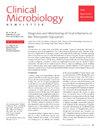Challenges in the phenotypic detection of streptococcus Pneumoniae from clinical samples in low resource settings
Q3 Medicine
引用次数: 0
Abstract
The phenotypic detection of Streptococcus pneumoniae in clinical samples, particularly those collected from infants, is vital for understanding its epidemiology and improving disease management. However, despite advancements in laboratory techniques, achieving optimal yield of Streptococcus pneumoniae remains a significant challenge. This paper explores the primary obstacles that compromise the effective recovery of Streptococcus pneumoniae from clinical samples and suggests potential strategies for improvement. One of the key issues identified are the effect of various sampling, transportation and storage techniques on the overall bacteria yield. Factors such as improper sample collection methods, inappropriate use or lack of use of transport media, and delays in processing can significantly diminish the viability of Streptococcus pneumoniae. In addition, the choice of culture media and conditions, while critical, may not always support the optimal growth of the bacterium, leading to false-negative results or underestimation of bacterial load. There is a need for a re-evaluation of current protocols, emphasizing the need for standardized procedures that are tailored to the specific requirements of pneumococcal detection. Further research into developing more resilient and specific culture media and better training for healthcare professionals involved in sample collection and processing should be encouraged. Addressing these challenges is crucial for improving diagnostic accuracy, guiding effective treatment strategies, and ultimately reducing the burden of pneumococcal disease.
低资源环境下临床样本中肺炎链球菌表型检测的挑战
临床样本中肺炎链球菌的表型检测,特别是那些从婴儿收集的样本,对于了解其流行病学和改善疾病管理至关重要。然而,尽管实验室技术取得了进步,但实现肺炎链球菌的最佳产量仍然是一个重大挑战。本文探讨了从临床样本中有效回收肺炎链球菌的主要障碍,并提出了潜在的改进策略。确定的关键问题之一是各种采样,运输和储存技术对总体细菌产量的影响。样本采集方法不当、运输介质使用不当或使用不足以及处理延误等因素可显著降低肺炎链球菌的生存能力。此外,培养基和条件的选择虽然至关重要,但可能并不总是支持细菌的最佳生长,导致假阴性结果或低估细菌负荷。有必要重新评估目前的方案,强调需要制定适合肺炎球菌检测具体要求的标准化程序。应鼓励进一步研究开发更具弹性和特异性的培养基,并对参与样本收集和处理的保健专业人员进行更好的培训。应对这些挑战对于提高诊断准确性、指导有效的治疗策略以及最终减轻肺炎球菌疾病的负担至关重要。
本文章由计算机程序翻译,如有差异,请以英文原文为准。
求助全文
约1分钟内获得全文
求助全文
来源期刊

Clinical Microbiology Newsletter
Medicine-Infectious Diseases
CiteScore
2.20
自引率
0.00%
发文量
35
审稿时长
53 days
期刊介绍:
Highly respected for its ability to keep pace with advances in this fast moving field, Clinical Microbiology Newsletter has quickly become a “benchmark” for anyone in the lab. Twice a month the newsletter reports on changes that affect your work, ranging from articles on new diagnostic techniques, to surveys of how readers handle blood cultures, to editorials questioning common procedures and suggesting new ones.
 求助内容:
求助内容: 应助结果提醒方式:
应助结果提醒方式:


